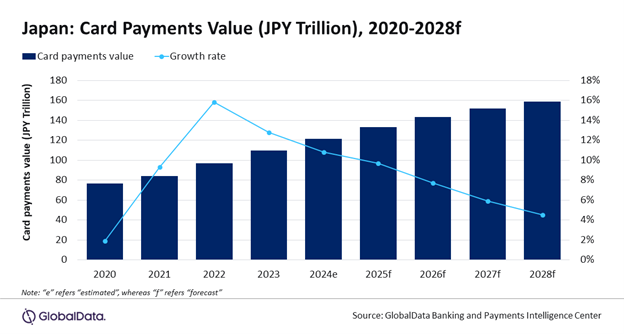
The Japan card payments market is forecast to grow by 10.8% in 2024 to reach JPY121.4trn ($866.8bn), supported by the growing consumer preference for non-cash payments, forecasts GlobalData, a leading data and analytics company.
GlobalData’s Payment Cards Analytics reveals that card payment value in Japan registered a growth of 15.8% in 2022, driven by the rise in consumer spending. The market continued its growth trajectory with 12.8% growth in 2023 to reach JPY109.6trn ($782bn).
How well do you really know your competitors?
Access the most comprehensive Company Profiles on the market, powered by GlobalData. Save hours of research. Gain competitive edge.

Thank you!
Your download email will arrive shortly
Not ready to buy yet? Download a free sample
We are confident about the unique quality of our Company Profiles. However, we want you to make the most beneficial decision for your business, so we offer a free sample that you can download by submitting the below form
By GlobalDataRavi Sharma, Lead Banking and Payments Analyst at GlobalData, comments: “Japan’s payment landscape is dominated by cash. However, this is undergoing a transformation, with electronic payments gaining traction and cash usage declining supported by the country’s large banked population and high financial awareness. With government initiatives to promote electronic transactions and improved payment infrastructure, payment cards grew in prominence over the years. Card issuers and payment services providers are focusing on developing payment infrastructure via the expansion of the payment acceptance network.”

Among the card types, credit and charge cards are the preferred card types in Japan, accounting for vast majority (96.5%) of total card payment transaction value in 2023
This is mainly due to the attractive reward programs offered by credit card issuers, which are considered more beneficial than those offered with debit and prepaid cards. Additionally, credit cards are widely accepted among merchants, making them a convenient choice for consumers.
On the other hand, debit card penetration in Japan is high, with everyone holding almost four debit cards. However, their usage has primarily been limited to cash withdrawals partly due to limited consumer awareness about using debit cards for payments and longer settlement periods for merchants.
The rise in e-commerce payments also contributed to this growth as payment cards are widely preferred payment tool for e-commerce purchase, with credit and charges alone accounted for 60.8% of the total e-commerce transaction value in 2023, according to GlobalData’s 2023 Financial Services Consumer Survey*.
As part of the government’s initiative to push electronic payments in the country, in April 2018, the Ministry of Economy, Trade and Industry released a cashless vision document with recommendations to achieve at least a 40% cashless payment ratio by 2025 and 80% in the long run. As part of this drive, the Cashless Promotion Association was established to promote electronic payments through various initiatives, including the standardisation of QR-code payments, raising awareness of electronic payments among individuals and businesses, the promotion of cashless payments at self-service kiosks, and the development and maintenance of cashless statistics.
Sharma concluded: “Looking ahead, the forecast for total card payments in Japan is promising. The growth in electronic payments, government initiatives, and advancements in payment infrastructure are expected to drive the growth of card payments in the country. However, challenges such as economic instability, and geopolitical uncertainty may pose obstacles to this growth. Nevertheless, Japan’s payment landscape is evolving, and card payments are set to play a more significant role in the country’s financial ecosystem. Overall, the card payments value is expected to register a strong compound annual growth rate (CAGR) of 6.9% betwe








